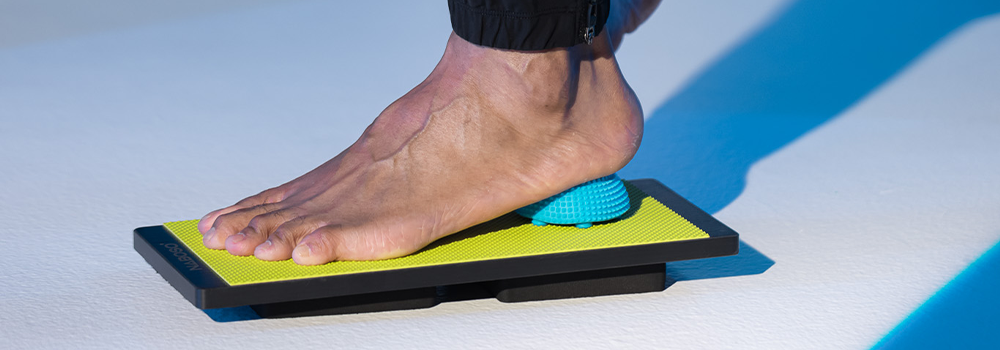Three Ways to Strengthen Foot Muscles

Physical inactivity is becoming a greater risk around the world, affecting more adults than ever before. Modern lifestyle relies heavily on technology. The downside of it is that it’s no longer necessary to be active to earn a living.
But the good news is, modern technology backed by scientific research can enhance and support a healthy lifestyle.
THE IRONY OF INCREASED EXERCISE
If you do more sports activities, you must be aware of how to keep your body safe and healthy while exercising. Studies show that the most common sprains and strains are related to sports: the ankle joint accounts for 72 percent of all injuries.
You might recognize the initial symptoms of swelling and ankle pain when jogging excessively or working out in the gym. If not treated, an ankle sprain can lead to secondary conditions. These include tendinitis, medial tibial stress syndrome, and medial knee pain. Up to 80 percent of patients who suffer a small ankle sprain will develop chronic ankle instability. More will experience permanent foot injury.
So how do we address this growing health problem? The best way is to ensure that while you are exercising, you are also strengthening your foot muscles. Balance, power, and strength are all factors in helping you perform physical exercises without the risk of injury.
Here are three ways to do that, backed by scientific proof:
Barefoot Training
Can training without sports shoes benefit your feet muscles? Absolutely!
Science has proven that it is far from normal for humans to be wearing closed or covered shoes all day long. Shoes support our feet, but they also restrict movement. They decrease flexibility and inhibit our muscles from performing as they should.
This is why many physical therapists recommend exercising barefoot. Look at yoga or Pilates athletes. Their agility and balance are enhanced when their feet aren’t restricted by shoes. Similarly, dancers are barefoot or wear flexible shoes that promote — not inhibit — movement.
When you train barefoot, you enhance sensory stimulation, improve joint health, and optimize balance. And when you are more stable, you’re less likely to suffer injuries due to a fall. To learn more about barefoot training check out the book Barefoot Strong by Dr Emily Splichal.
Short Foot Exercise
Many active people suffer from plantar fascial pain and metatarsalgia. This is often due to a weakness in the small foot muscles. Short foot exercise (SFE) or “foot doming” is one of the most effective foot exercises which can improve this. The exercise conditions your feet muscles for endurance. It requires no equipment, and you can do it anywhere — even seated.
How does SFE work?
Start by finding your foot tripod which is under your first toe, fifth toe and heel. Lift the toes, spread them out and place them back down onto the ground. Using your intrinsic foot muscles, start to push the tips of the toes down into the ground. Hold for 10 seconds. Relax and repeat five times per side. If you experience cramping, simply relax, and try again later. To see a full video on how to perform SFE click HERE
In one study, short foot exercise was used to address chronic foot instability. Thirty adults were monitored during exercise for eight weeks. Scientists measured the quantitative somatosensory of joint position sense, vibration sensory thresholds, balance, and ankle instability. The group that performed the short foot exercise showed significant improvement in all the categories. SFE was more effective than regular physical therapy for treating ankle sprain patients.
Texture Stimulation
Your feet can affect everything else in your body. How you exercise will directly affect the pressure on your knees, hips, low back, and neck, so it can lead to many injuries.
When exercising, pay attention to the skin on the bottom of your feet. It is critical for balance, posture, motor control and human locomotion. Using scientifically backed texture technology during exercise protects your soles. It ensures you get the most out of your workouts, every time. Naboso has both textured mats and insoles that are perfect for strengthening your feet and body.
The Naboso mat was developed by Podiatrist and Human Movement Specialist Dr. Emily Splichal. It has a unique, patent-pending material based on texture research and surface science. The unique texture will stimulate your body’s nervous system through the skin on the bottom of your feet. When using it, you may notice an improvement in your postural control, stability, and strength.
Here are three ways you can use the Naboso Mat:
- To optimize foot stimulation during standing barefoot exercises
- When exercising with kettlebells, sandbags, or Olympic lifting
- While doing barefoot bodyweight exercises such as step-ups or lunges
Similarly, Naboso Insoles work by stimulating the nerves in the bottom of your feet. They not only improve balance but positively impact gait patterns, ankle proprioception and force production.
You can think of Naboso like “braille for the feet.” Naboso material lets your feet “read” the ground. With every movement, you become stronger, more flexible, and empowered.
For more information about Naboso, visit our website and explore our product line today.